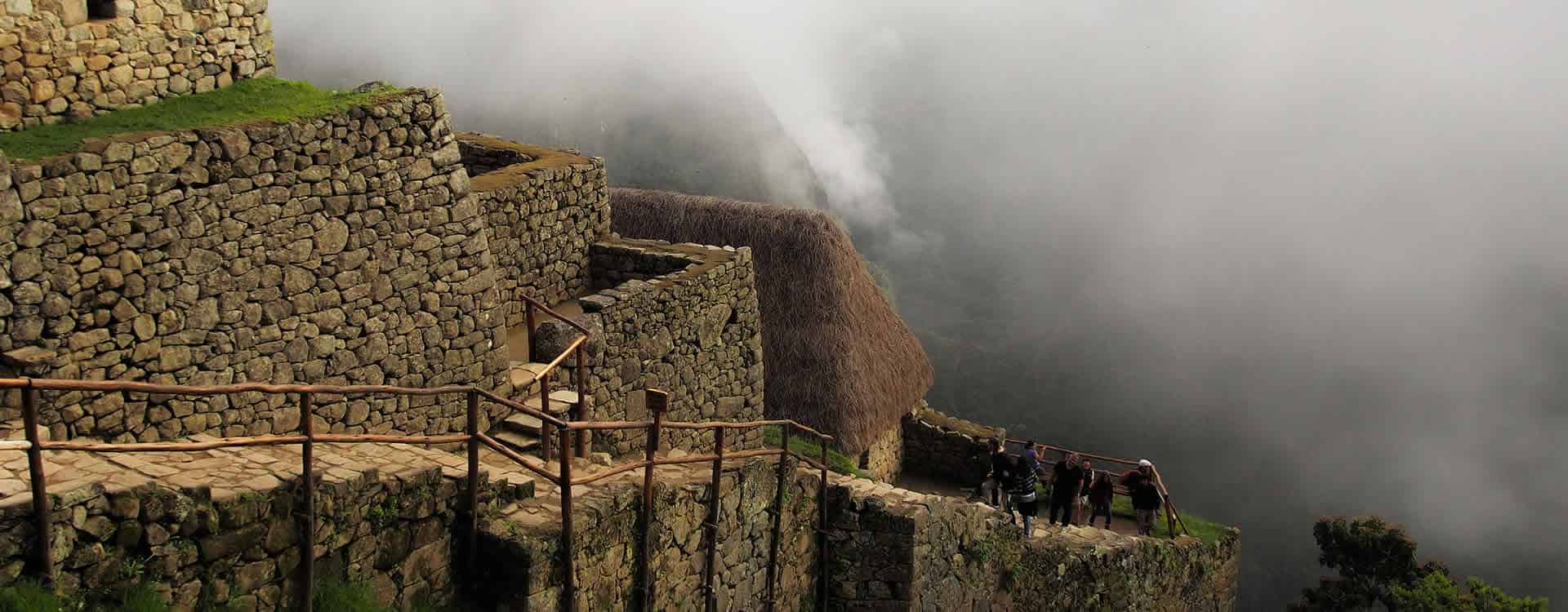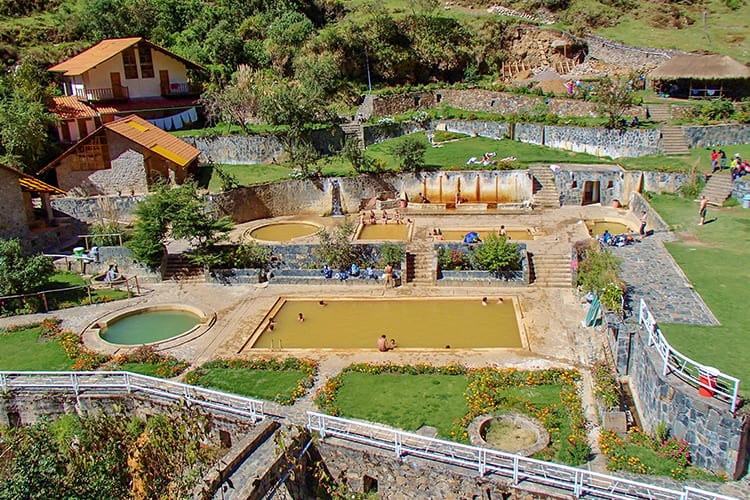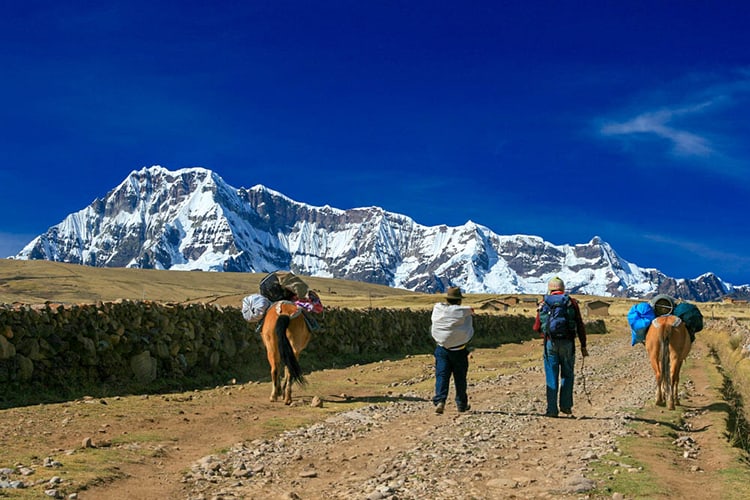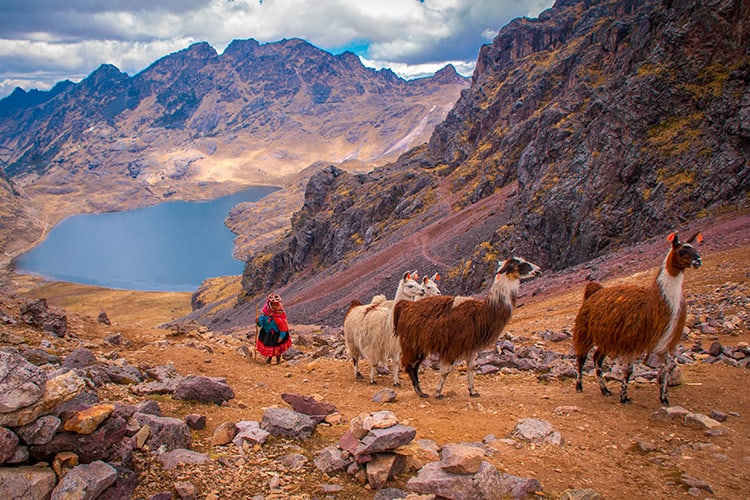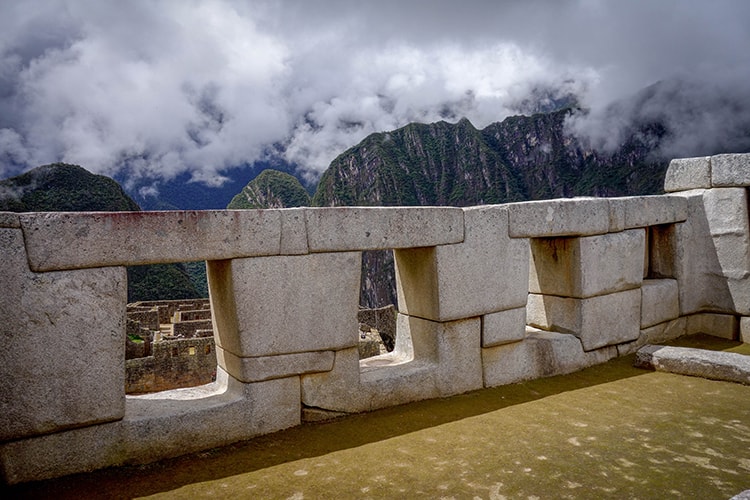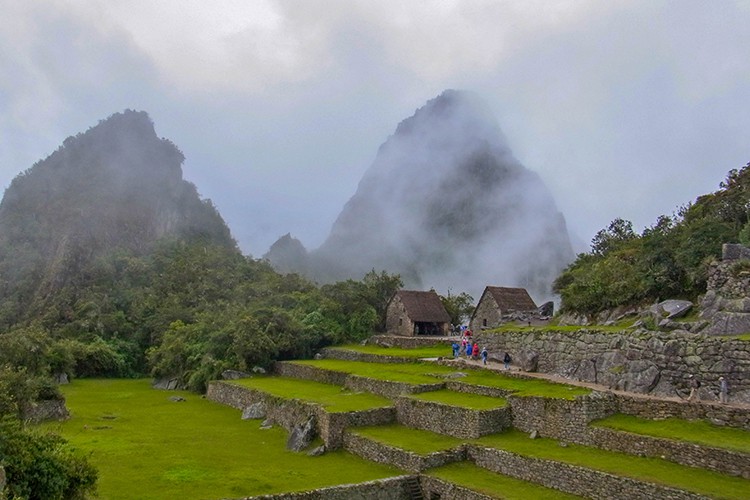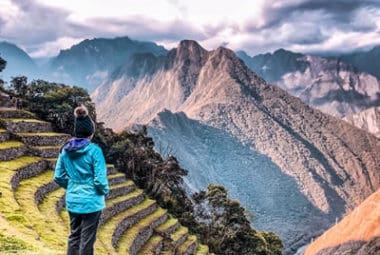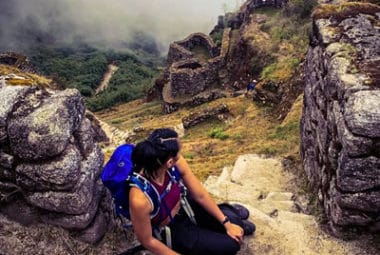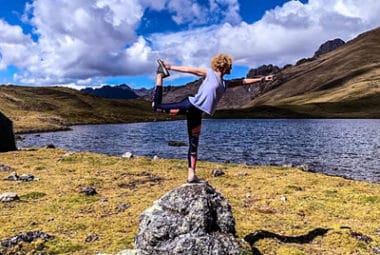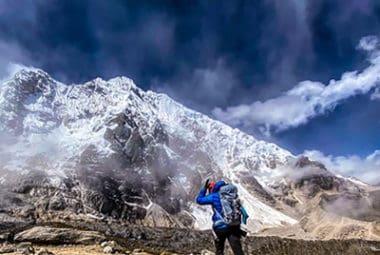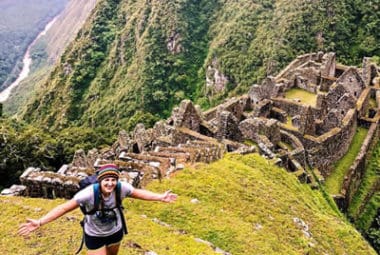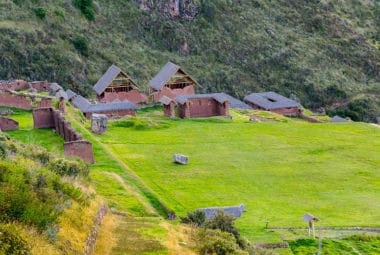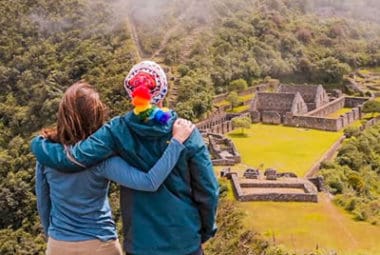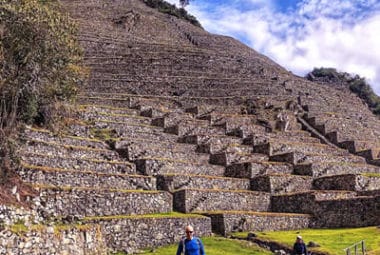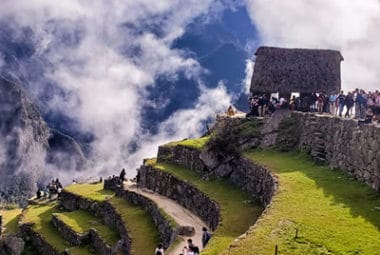Tour Details
Lares Trek to Machu Picchu
- Day 1: Cusco – Famous Thermal Baths – Kiswarani Waterfall Campsite.
- Day 2: Quiswarani – Condor Pass – Cancha Cancha Village.
- Day 3: Cancha Cancha – Huaran – Maras Salt Mine – Ollantaytambo – Aguas Calientes.
- Day 4: Machu Picchu – Ollantaytambo – Cusco.
Itinerary
Lares Trek to Machu Picchu
Day 1: Cusco – Famous Thermal Baths – Kiswarani Waterfall Campsite.
We will pick you from your hotel at 5 a.m. to begin the famous Lares Trek. We can pick you from any hotel, condo, or apartment, if it is located in the cities of Cusco, Urubamba, Huaran or Pisaq. It will be a three hour drive along the beautiful landscape of the Sacred Valley and through the Andes, until we arrive at the Lares Hot Springs site, where you will have your first breakfast accompanied by amazing views of the Andes Mountains. Then, you will enjoy the hot springs, which are divided into various pools ranging from freezing cold to boiling. They are all composed of pure volcanic water, which is medicinal in nature and considered to be good for your bones, stress, muscles and headaches.
After soaking in the baths for a while, you will drive 20 minutes to the trail head, Punta Carretera at 3,300 m/ 10,827 ft above sea level. It is here that you will meet up with your horses and horsemen. You will give your duffel bags to the horsemen to be transported to the campsite. Following, you will begin your expedition to Machu Picchu. To start, it will be a two hour, gradual uphill hike, until we reach our lunch spot at the first village, called Kiswarani. This section of the hike is considered the potato valley sector, where people farm many varieties of organic potatoes. Your guide will also point out some indigenous, medicinal plants growing along the way. Then, we will arrive at our lunch spot, where you will enjoy your first delicious meal prepared by our trekking chef.
After lunch, our horsemen (llameros) will do a ceremony with llamas showcasing these beautiful animals. Llamas were considered sacred to the incas and fundamental to their economy. Our llameros will introduce you to these animals and discuss their importance and why owning one was a sign of priveledge. Today they are disappearing, constantly breaded with smaller animals. We hope to continue the tradition of the incas and give some llamas work. This is our way of supporting the community that helps protect them. Llamas are friendly and strong animals and are a nice companion to walk with. Just don’t get too close, they might try to give you a kiss.
You will also have time to explore the village and visit some local homes, where you will learn about the lifestyle and ancient traditions of the local people. If there is time, we will visit the school where the kids still speak Quecha, their native language. If you’d like, you may bring some toys, notebooks or any type of school supplies to share. Perhaps you may even teach them a few English words. It will be another two hour, gradual, uphill hike until we arrive at the campsite, where you will be welcomed by our trekking staff, who will have your tents set up. We’ll enjoy some hot drinks, as the sky darkens and the stars start appearing. Finally, you will enjoy a lovely dinner prepared on site. If you want to keep star-gazing, you may stay up for a while longer or, if you’d rather, you can turn in to your tent.
Trekking Distance: 10 km/ 6.21371 miles
Camp Elevation: 3,850 meters / 1,2631 ft
Weather: Cold
Day 2: Quiswarani – Condor Pass – Cancha Cancha Village
Today you will be woken up around 5 a.m., with our service of hot drinks. You will have amazing views of the colorful lake and the valley of Kiswarani. The local people will already be up and about, taking their llamas and alpacas out to graze. Breakfast will be served as soon as you finish packing your gear. Then we’ll fill up our water bottles, organize snacks and you will begin the most memorable day of your expedition to Machu Picchu. It will be a three or four hour climb to get to the summit of the mountain. This pass is called Pachacute, or Condor Pass. We’ll zigzag our way up to compensate for the steep uphill. The views of the area are stunning. You will see lakes, waterfalls, llamas, and alpacas. We will have an emergency horse to ride in case you are tired. Once you arrive at the Condor Pass you will be above the clouds, above the mountain peaks and the surrounding 360 degree views are astounding. In front of you will be the majestic mountain of Pitusiray, which is at 5,700 m/ 18,700 ft high, and the Condor pass is at 4,680 m/ 15,354 ft high. Afterwards, we will enjoy the hot drink service that your porters will carry with them. We will take advantage of some phenomenal photo opportunities, and start our descent.
You will begin the one hour, downhill, descent towards El Mirador (Vista Point), where you will enjoy lunch. There will perhaps be some llamas grazing nearby. After lunch, you will hike the last three hours downhill, with fantastic views of many lakes, llamas and alpacas, before arriving at your campsite, the village of Cancha Cancha, which is the only village that does not have modern technology. Cancha Cancha is a village (3,750 m/ 12,303 ft) where people still practice real traditions of the Incas. In this Incan village, 85 percent of the houses are still composed of original, ancient construction, made of stone, with grass-thatched roofs. Unlike any other village in the Lares Valley, this village where has no electricity or cars.
Here, you will not only enjoy the wilderness, but your porters will also set up your tents. You will have some time to meet with the local children. We provide them with food and school supplies, so we invite our travelers to share this support in the education and the health of this native village. You can join us and bring anything you would like to supplement the lives of these Quechuan-speaking children. Following, your guide will take you to one of the local family’s houses, where you will learn about the lifestyle of the locals. You can see how they raise their guinea pigs, and you will learn about the traditional, hand-woven textiles, made of llama and alpaca wool. This is the best day of your hike. In the evening you will enjoy hot drinks and dinner.
Walking Distance: 14 km/8 miles
Elevation Gain: 830 meters / 2,723 ft
Camp Elevation: 3,750 meters / 12,303 ft
Weather: Cold
Day 3: Cancha Cancha – Huaran – Maras Salt Mine – Ollantaytambo – Aguas Calientes.
Our porters will wake you up with a hot drink and you will have some time to pack your bags and enjoy breakfast. After breakfast, you’ll have time to explore the village and visit the local elementary school, where the ancient Inca language, Quechua, is still taught. Once you are ready, you’ll begin the last leg of your Lares trek. It will be four hours of walking downhill, along this lovely path, where you will pass by more llamas and alpacas. We’ll pass by farms where they cultivate potatoes, fava beans, and many other traditional tubers, in the traditional Incan style. This is a great opportunity to learn about Peruvian agriculture because people still farm by hand with traditional, Inca farming tools. Now, we will start to descend to the warmer area, The Sacred Valley. You will begin to feel the micro-climate changes and start seeing crops that are different from in the high mountains. Around the Sacred Valley people farm corn, quinoa, kiwi, peaches, avocados and other types of fruits. Of course, this area has a lot of Incan history. You will end the tour at the little village of Huaran, in the Sacred Valley, at 2,700m / 8,858 ft where you will say goodbye to your horses, horsemen, chef and porters, as they will be going back to their homes.
From Huaran, we will catch a van and make the short drive into the valley to visit the Salineras salt pans, in the town of Maras. Here, at 11,000 feet above sea level, a salt water spring gushes forth and spills down the side of the mountain. Over 3,000 small evaporation chambers have been created and look as if they are tumbling down the mountainside. These have been in use since pre-Incan times. The salt is said to have healing properties because it is loaded with natural minerals, some of it even comes out pink. Local families each own one of these pans, and make their living supplying salt to the towns around the area. There is a small shop on site, if you care to take some salt home with you.
After visiting Salineras, we will climb aboard the van for a 45 minute drive, that skirts along the Sacred Valley to Ollantaytambo. Ollantaytambo is the only living, intact Inca village. It still has many Inca water channels, houses and walls. Your guide will take you around to view this small town until it is time for dinner, which will be at a local restaurant. We’ll then catch the 7 p.m. train for Aguas Calientes, the town below Machu Picchu (train times may vary, depending on availability). Upon your arrival to Aguas Calientes, you will check-in to your hotel and relax.
Walking Distance: 9 km /6.2 miles
Aguas Calientes Elevation: 2,000 m / 6,562 ft
Weather: Cold in the morning, warm in the afternoon. Watch out for mosquitoes this day.
Accommodations: inti punku or similar.
Day 4: Machu Picchu – Ollantaytambo – Cusco
Day four is the most magical day because you will finally experience Machu Picchu. You will wake up early to catch one of the first buses (around 5:30 a.m.), for the 30 minute ride up to Machu Picchu. You will see the Sunrise over the ruins. Your guide will take you for an informative two hour tour. Afterwards, you will have time to explore on your own and hike Huayna Picchu if you choose to (this is a separate entrance ticket and costs $75 per person). In the afternoon, you’ll catch a two hour train back to Ollantaytambo, followed by a bus back to Cusco, where we will transfer you to your hotel.
Weather: Warm and humid
Note:
- If you want to stay an extra night in Aguas Calientes, please let us know in advance. We can adjust your train tickets and arrange for a hotel, if you would like us to help.
- Rangers do not allow people to carry large backpacks inside Machu Picchu. Only day packs are allowed inside.
- No trekking poles are allowed in Machu Picchu.
- Snacks and water are allowed, but they must be inside your backpack.
Included
What is included?
- (Briefing): You’ll meet your guide and group . The meeting will take place the night before your trip at 6:00 PM in our office (plazoleta jesus lambarri) .
- Transportation: Cusco/ Huarán-Ollantaytambo-Aguas Calientes-Ollantaytambo-Cusco
- Qualified guides: Our guides speak English and Spanish, professional education and official certification. They will explain to you about the history, culture and environment along the trail, as well as lead the group in ancestral rituals and ceremonies. They’ll also take care of your safety, health and comfort during the trip so you can enjoy the trek worry-free.
- Lodging in campsites: We have a series of campsites that offer you true comfort. Besides that, just like our ancestors, we have a profound link of affection and respect for our Mother Earth, and because of this, we are insistent that our campsites don’t generate negative environmental affects. Remember that the accommodations are double and shared.
- Camping equipment: We have tents for cooking and eating, as well as tables, chairs and complete kitchen equipment. All of this is transported by horses.
- Entrance ticket to the archeological complex of Machu Picchu
- Hotel in the town of Aguas Calientes: During the last night of the trek, you’ll spend the night in a shared room with private bathroom, hot water, wi-fi, boxed breakfast and luggage storage while you visit Machu Picchu.
- 1 duffle bag: There, you can carry your personal belongings (including your sleeping bag) up to a maximum weight of 5 kg
- Pack mules: Our pack mules will transport all camping equipment, as well as your personal luggage in the canvas bag.
- Cooking services: A specialized trekking chef, along with his assistant, will prepare you delicious dished of Peruvian cuisine along the way so you can replenish your energies. You’ll never be hungry!
- Meals: 3 breakfasts, 3 lunches and 3 dinners. Special menus such as vegetarian or vegan meals are available without additional costs.
- Morning tea: Every morning in our campsites, you’ll enjoy a cup of hot coca tea as soon as you wake up. It will be an excellent way to start the day.
- Tea time: In our campsites, we’ll serve you popcorn, cookies, coffee, chocolate, tea, hot water, etc. After a long day of hiking, you won’t have to wait until dinner to fill your stomach.
- Snacks (Days 1, 2 & 3): We’ll offer you delicious snacks in a cloth bag: local fruits, cookies, chocolates, candy, etc
- First-aid kit: We have a the necessary materials ready for any minor incident.
- Oxygen cilinder
- Trail tickets: From Aguas Calientes to Ollantaytambo at about 4:22 PM, depending on the availability
Does not include:
- Sleeping bag: However, you can rent one from us. We have sleeping bags that will protect from down to -18 °C (0 °F).
- walking sticks: You can also rent these from us.
- Lunch and dinner on the last day
- Clothing and personal equipment
- Travel insurance
- Tips for our team: Keep in mind that our personnel receive payment for their services, so feel free to give tips or not.
- Bus tickets Aguas Calientes-Machu Picchu-Aguas Calientes
- Additional costs: There could be additional expenses, delays or modifications of the itinerary that are outside of the responsibility of the agency, such as: bad weather conditions, security or health problems, changes in government policies, political instability, strikes, etc.


